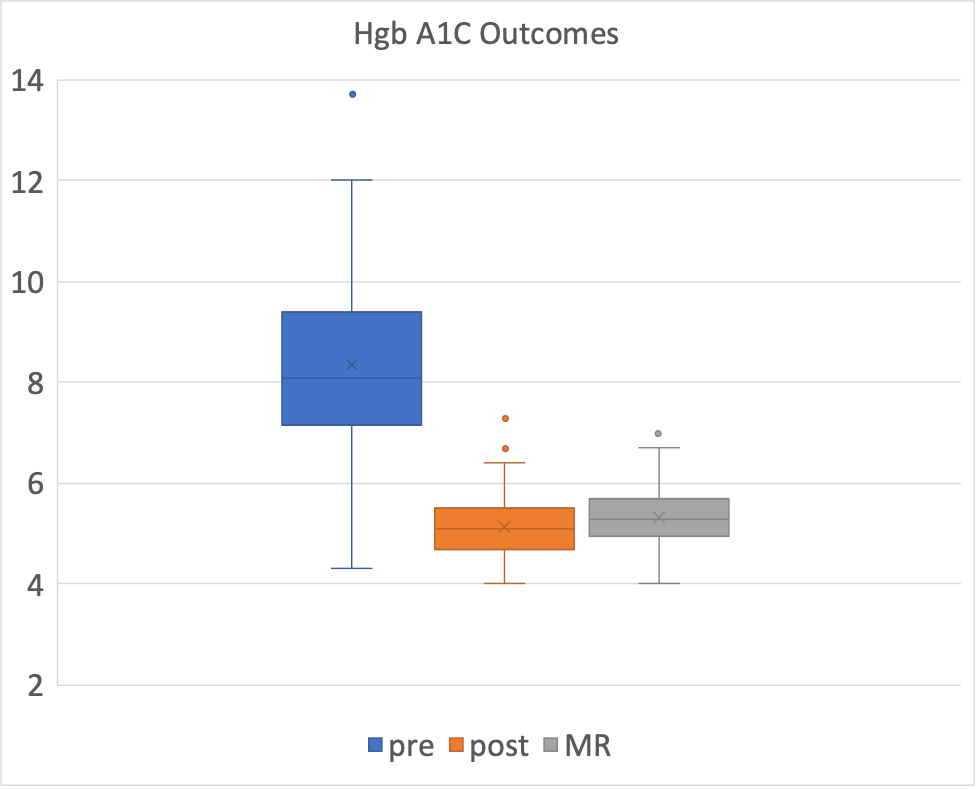Solid Organ Pancreas Transplantation Offers Superior Glycemic Control Compared to State of the Art Insulin Delivery with Continuous Glucose Monitoring (CGM)
Columbia University, New York, NY
Meeting: 2022 American Transplant Congress
Abstract number: 1153
Keywords: Graft function, Pancreas, Pancreas transplantation, Surgery
Topic: Clinical Science » Pancreas » 65 - Pancreas and Islet: All Topics
Session Information
Session Name: Pancreas and Islet: All Topics
Session Type: Poster Abstract
Date: Sunday, June 5, 2022
Session Time: 7:00pm-8:00pm
 Presentation Time: 7:00pm-8:00pm
Presentation Time: 7:00pm-8:00pm
Location: Hynes Halls C & D
*Purpose: Advanced insulin delivery systems with CGM fail to keep serum glucose within range (70-180 mmol/L) 30-40% of the time resulting in Hgb A1C goals of 6.5-8%, and continue to have issues with severe hypoglycemic events. We wanted to assess how pancreas transplantation performed compared to our competitors.
*Methods: We conducted a retrospective review of pancreas transplantation at our institution from January 1, 2008 through August 1, 2021. All patients 18 years and older who underwent simultaneous kidney pancreas transplant (SPK), pancreas after kidney transplant (PAK), and pancreas transplant alone (PTA) were included. Outcomes were assessed by Hgb A1C level pretransplant (pre), within the first 3 to 5 months posttransplant (post) and the most recent follow up (MR) (avg 62 months SD 75.4 months).
*Results: 133 patients underwent pancreas transplantation during the study period, 85 SPK (62%) 39 PAK (30%) and 11 PTA (8%). 19 (14%) patients suffered pancreas graft loss in the first year and were excluded from the analysis. Overall, 1, 3, and 5-year graft survival was 86%, 84% and 82% respectively. Of the 114 patients remaining, 96 (84%) were type 1 diabetes diabetics (T1D) and 18 (16%) were type 2 diabetics (T2D). 9 patients have resumed antihyperglycemic therapy not meeting UNOS criteria for failure. There have been 7 graft failures within the study period, and 8 patients have died (>5 years posttransplant). The average HgbA1C pre, post, and MR were 8.3% (SD 1.7) and 5.1% (SD 0.61) (p=0.00026) and 5.3% (SD 0.63) (p=0.91) (fig 1). Of the grafts studied, all had a Hgb A1C of 7% or less. 86% had a Hgb A1C of less than 6% in the post and most recent assessment. There was no significant difference between Hgb A1C outcomes from T1D vs T2D groups. There were no severe hypoglycemic events of patients with functioning grafts.
*Conclusions: Solid organ pancreas transplantation offers superior glycemic control compared to advanced insulin delivery systems. Staying within range is clinically challenging with exogenous insulin regimens due to balancing individual risk of severe hypoglycemic events, leading to Hgb A1C of greater than 7% in most series, a goal that is easily surpassed durably in pancreas transplantation.
To cite this abstract in AMA style:
McCune KR, Dube GK, Sandoval PR, Ratner LE. Solid Organ Pancreas Transplantation Offers Superior Glycemic Control Compared to State of the Art Insulin Delivery with Continuous Glucose Monitoring (CGM) [abstract]. Am J Transplant. 2022; 22 (suppl 3). https://atcmeetingabstracts.com/abstract/solid-organ-pancreas-transplantation-offers-superior-glycemic-control-compared-to-state-of-the-art-insulin-delivery-with-continuous-glucose-monitoring-cgm/. Accessed December 18, 2025.« Back to 2022 American Transplant Congress

